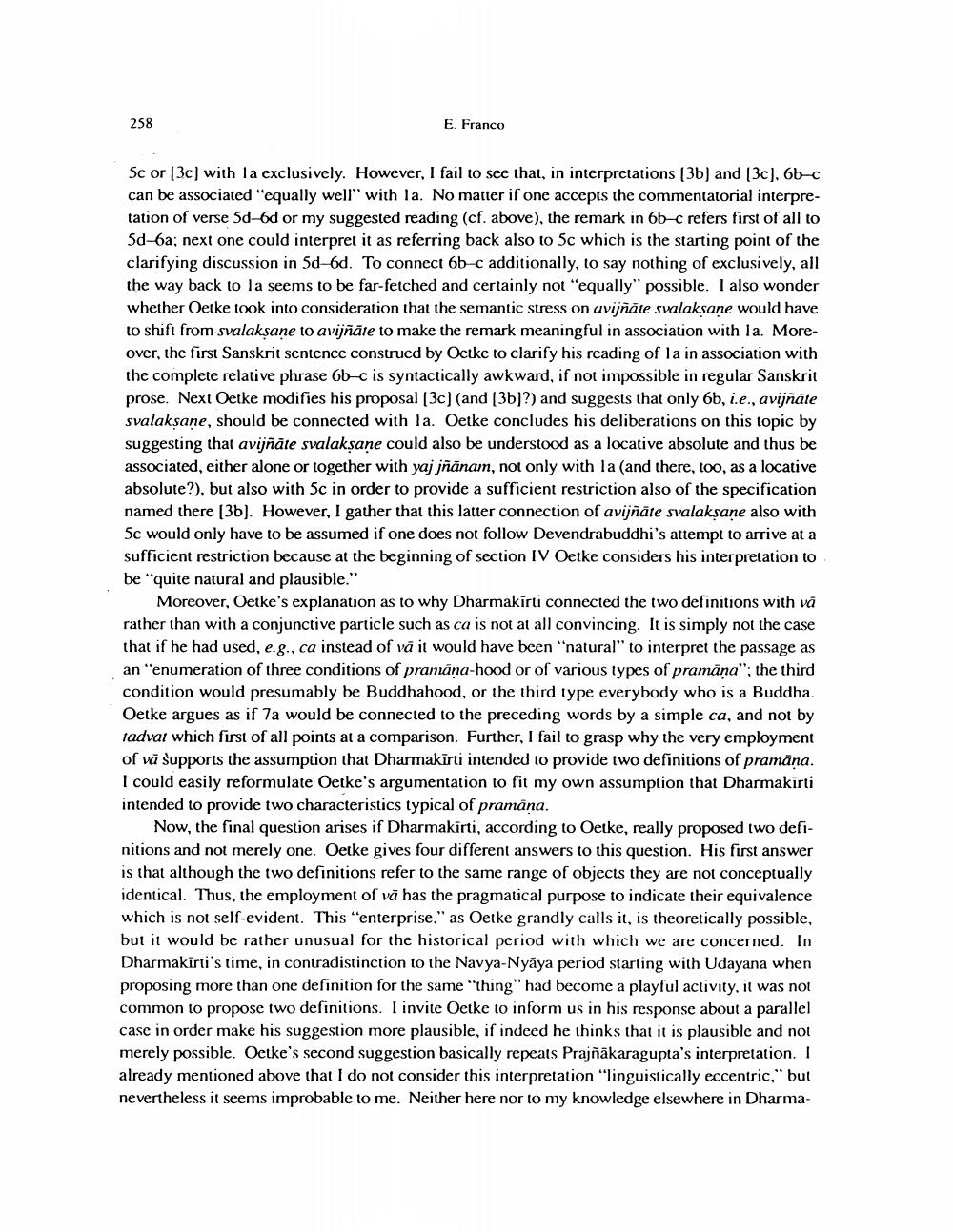Book Title: Response To Claus Obteks Paper Author(s): Eli Franco Publisher: Eli Franco View full book textPage 6
________________ 258 E. Franco 5c or (3c) with la exclusively. However, I fail to see that, in interpretations (3b) and (3c), 6b-c can be associated "equally well" with la. No matter if one accepts the commentatorial interpretation of verse 50-60 or my suggested reading (cf. above), the remark in 6b-c refers first of all to 50-6a; next one could interpret it as referring back also to 5c which is the starting point of the clarifying discussion in 50-60. To connect 6b-c additionally, to say nothing of exclusively, all the way back to la seems to be far-fetched and certainly not "equally" possible. I also wonder whether Oetke took into consideration that the semantic stress on uvijñāte svalaksane would have to shift from svalaksane to avijñāte to make the remark meaningful in association with la. Moreover, the first Sanskrit sentence construed by Oetke to clarify his reading of la in association with the complete relative phrase 6b-c is syntactically awkward, if not impossible in regular Sanskrit prose. Next Oetke modifies his proposal (3c) (and (3b]?) and suggests that only 6b, i.e., avijñāte svalaksane, should be connected with la. Oetke concludes his deliberations on this topic by suggesting that avijñāte svalaksane could also be understood as a locative absolute and thus be associated, either alone or together with yaj inānam, not only with la (and there, too, as a locative absolute?), but also with 5c in order to provide a sufficient restriction also of the specification named there (3b). However, I gather that this latter connection of avijñāte svalaksane also with 5c would only have to be assumed if one does not follow Devendrabuddhi's attempt to arrive at a sufficient restriction because at the beginning of section IV Oetke considers his interpretation to be "quite natural and plausible." Moreover, Oetke's explanation as to why Dharmakirti connected the two definitions with vā rather than with a conjunctive particle such as ca is not at all convincing. It is simply not the case that if he had used, e.g., ca instead of vā it would have been "natural" to interpret the passage as an "enumeration of three conditions of pramāna-hood or of various types of pramāna"; the third condition would presumably be Buddhahood, or the third type everybody who is a Buddha. Oetke argues as if 7a would be connected to the preceding words by a simple ca, and not by tadvat which first of all points at a comparison. Further, I fail to grasp why the very employment of vă supports the assumption that Dharmakīrti intended to provide two definitions of pramāna. I could easily reformulate Oetke's argumentation to fit my own assumption that Dharmakīrti intended to provide two characteristics typical of pramana. Now, the final question arises if Dharmakirti, according to Oetke, really proposed two definitions and not merely one. Oetke gives four different answers to this question. His first answer is that although the two definitions refer to the same range of objects they are not conceptually identical. Thus, the employment of vā has the pragmatical purpose to indicate their equivalence which is not self-evident. This “enterprise," as Oetke grandly calls it, is theoretically possible, but it would be rather unusual for the historical period with which we are concerned. In Dharmakīrti's time, in contradistinction to the Navya-Nyāya period starting with Udayana when proposing more than one definition for the same thing" had become a playful activity, it was not common to propose two definitions. I invite Oetke to inform us in his response about a parallel case in order make his suggestion more plausible, if indeed he thinks that it is plausible and not merely possible. Oetke's second suggestion basically repeats Prajñākaragupta's interpretation. I already mentioned above that I do not consider this interpretation "linguistically eccentric," but nevertheless it seems improbable to me. Neither here nor to my knowledge elsewhere in DharmaPage Navigation
1 ... 4 5 6 7
